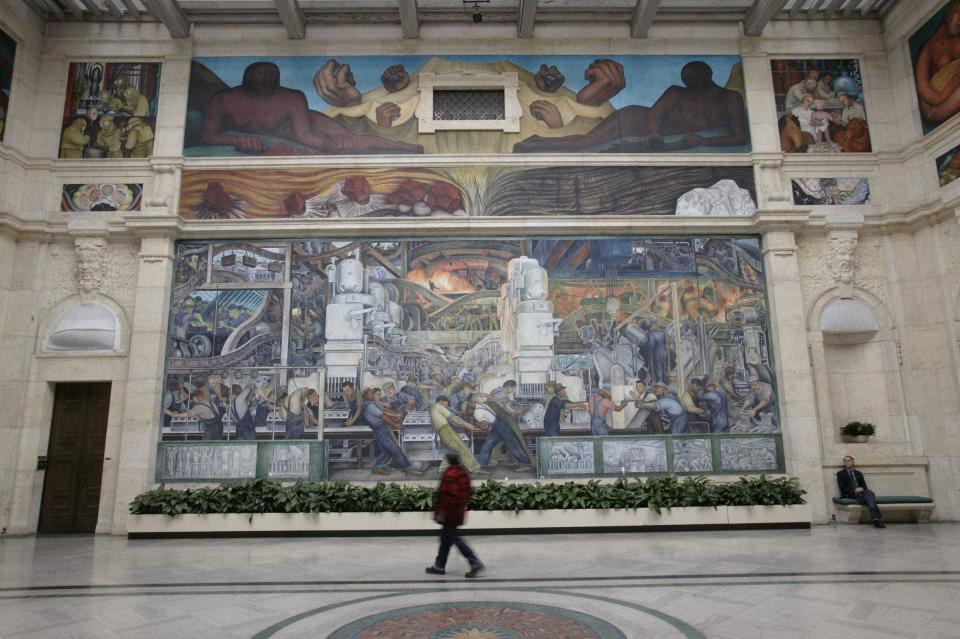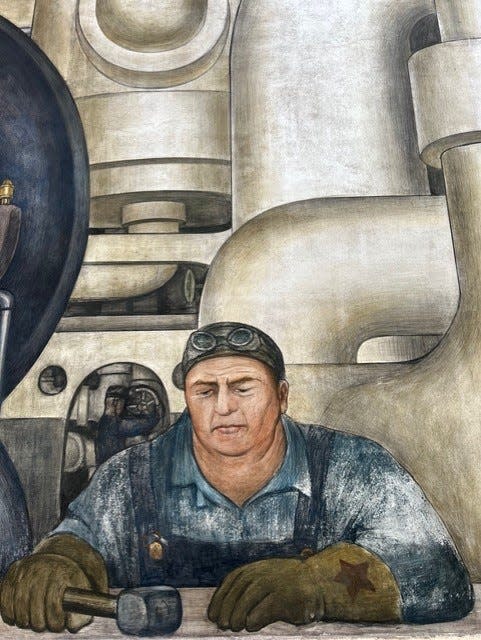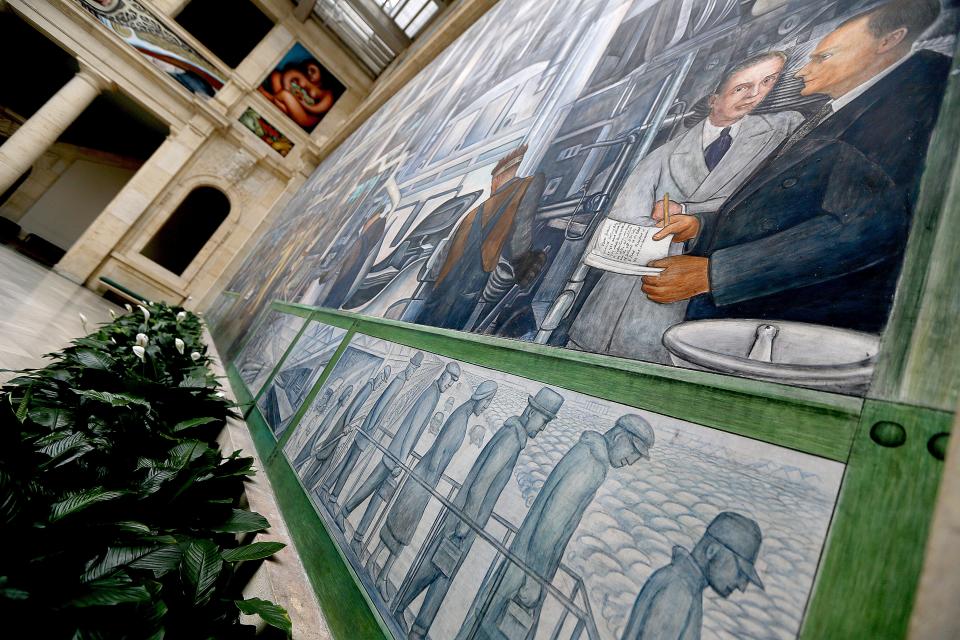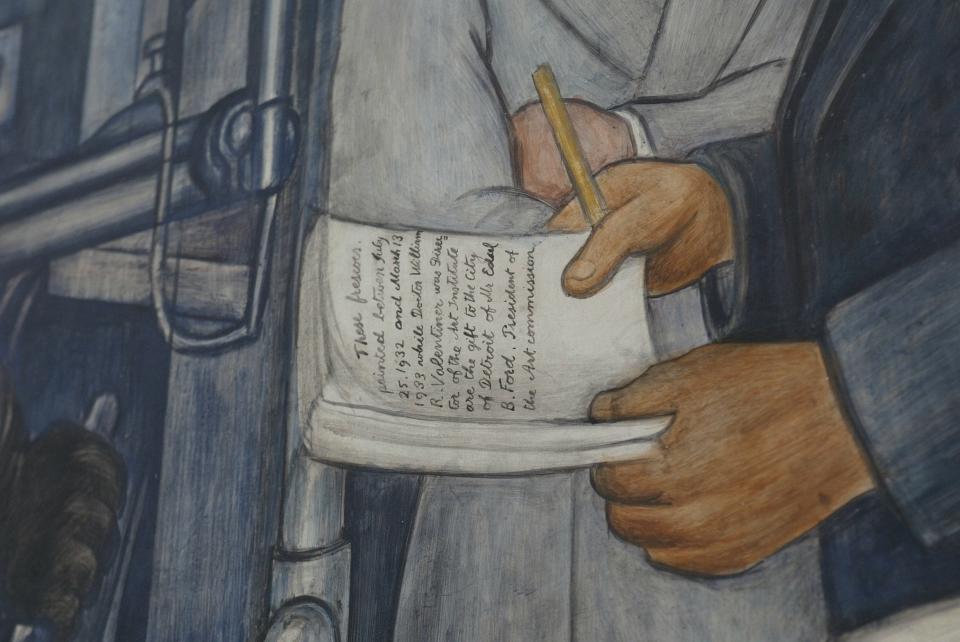Flashback: The paint was barely dry when some leading Detroiters attacked Rivera murals
Virtually all metro Detroiters today agree that Diego Rivera's "Detroit Industry Murals" in the Detroit Institute of Arts are among the region’s greatest treasures. But the unveiling of the artwork 90 years ago ignited a ferocious debate; many people assailed the murals as god-mocking, communist propaganda. The following story appeared as the controversy was getting underway. It ran on Page One of the Free Press on March 21, 1933, and has been lightly edited for length.
Monday was a day of words in the controversy over the frescoes of Diego Rivera in the Garden Court of the Detroit Institute of Arts.
The Rivera murals were discussed at two meetings.
The committee of eight objectors who met with the Rev. Ralph Higgins, senior curate of St. Paul's Cathedral, decided to postpone action until a larger group could be assembled.

George Hermann Derry, president of Marygrove College and a member of the committee, issued a statement following the meeting, stating that "Senor Rivera has perpetrated a heartless hoax on his capitalist employer, Mr. Edsel Ford."
An attack on this gift of Edsel B. Ford, who is president of the Arts Commission, was also launched in the Common Council budget hearings Monday when Mr. Ford appeared with Clyde H. Burroughs and other officials of the Institute for a review of the Museum's appropriations for 1933-34.
Councilman William P. Bradley seized upon the occasion to deliver a 15-minute attack against the Rivera murals, describing them as a travesty and nothing but "caricatures which have offended thousands."
Meanwhile, the People's Museum Association announced a meeting for 11 a.m. Wednesday in the small lecture hall of the Detroit Institute of Arts. The meeting will be open to the public. Fred L. Black, chairman of the People’s Museum Association, is ranked among the defenders of the murals, which he terms "Detroit's great contribution to fine arts."
He said, "Mr. Rivera has pictured most perfectly the essence of the indomitable industrialism which has made Detroit famous all over the world. The beauty of the frescoes lies in their rugged truth. I am very proud of them."
But the interpretation of just what the "rugged truth" might be is being furiously debated. In one camp are those who declare that "in years to come the frescoes will be ranked among the truly great art treasures of America." In the other camp are those who have gone so far as to demand that the frescoes be removed from the Institute walls, using "something more than whitewash, because they do not portray the spirit of our age."
‘All art is propaganda’
Monday's first meeting was in the Women's City Club, where the art committee of the Detroit Review Club, Mrs. August Helbig, chairman, had invited Eugene S. Paulus to address the members.
Mr. Higgins was also present at the beginning of the meeting. He restated his objections, previously made public, and termed Mr. Paulus "the Hound of Heaven” in the artistic sense" for his attacks on the murals.

Mr. Paulus reviewed Rivera's history and quoted him as having said that "all art is for propaganda purposes." He claimed that a symbol representing the Communist fist is painted on the "tax-paid walls" of the Institute, where in the “Holy Family's caricature" the Marxian belief that "religion is an opiate for the people" is expressed so that "religion is a marble disc weighing down the people."
He further objected to another portion of the murals on the ground that "in a high school they wouldn't tolerate such a detailed sketch in the class books."
Apropos of this, a statement issued Monday by Dr. W. R. Valentiner, director of the Institute, said in part, "I do not believe that anyone can question the artistic quality of Mr. Rivera's work. No one expects any work of art to please everyone equally, but any suggestion of pornography in these frescoes is too absurd to be taken seriously.
"I can assure the public that no article is included in our collections because of either religious or anti-religious reasons; it must have an historical or an artistic significance."
Detroit: Laughing stock?
Dr. Valentiner also said that "it would be as out of place for me to ask Rivera to change his paintings at the request of any religious or political organization as it would be for me to remove the many crucifixes, religious paintings and church relics from our collections because they gave offense to Jews, unorthodox Christians and the thousands who have no interest in any church.
"If any religious body desires to check up the Art Institute inventory from the point of view of religious souvenirs, they will find that the amount of taxpayer's money invested in symbols, emblems, and decorations of the Christian faith far exceeds any other."
Following Mr. Paulus' remarks, a champion of the murals arose on the floor in person of Mrs. L. O. Moon, 3744 W. Philadelphia Ave.
"I am sorry Detroit is laying itself open to be laughed at all over the world," she said.
"My only objection to the murals is that they have been placed in a room too small for them.
“But whatever you think of it, this is a changing age. I'm not a Communist, not even a socialist. In fact, I voted for Herbert Hoover. But whether we like it or not, we are passing from one age to another and it is fitting that we should put into art in Detroit something of the present age. It hurts when an old age dies and a new age is born, but Diego Rivera is in the first place an American and he paints on the American rhythm.”
J. W. Lyons, who said he was secretary to an artist whom he refused to name, and who said he had worked on an assembly line in a Detroit automobile factory, was invited to the platform.
"I ought to be a pretty good judge of art," he said, "because I am not an artist and also because I am color blind.
The work of Rivera is a disgrace from the technical point of view. Art must be beautiful."

Edsel weighs in
Mr. Higgins said the committee felt that Dr. Valentiner’s remark that some Detroiters objecting to the frescoes have let their religious enthusiasm run away with their better judgment was "unfair."
A formal protest to the Arts Commission is expected to be launched, though Mr. Higgins said that "there is no need for haste." In his statement, Dr. Derry said: "Senor Rivera was engaged to interpret Detroit; he has foisted on Mr. Ford and on the Museum a Communist manifesto. Dr. Valentiner is gravely at error in assuming that the opposition to the murals is merely religious.

“The key panel that first strikes the eye, when you enter the room, betrays the Communist motif that animates and alone explains the whole ensemble."
After the council session at the City Hall, Edsel B. Ford told newspapermen that he admired Rivera's work. When asked if he thought the murals an "accurate portrayal of industrial Detroit?" Mr. Ford replied, "It is Rivera's interpretation."
The murals were made possible by a contribution of $25,000 from Mr. Ford, whose term as president of the Art Commission technically expired March 1. It is understood that at that time Mr. Ford tendered his resignation to Mayor Frank Murphy but was urgently requested a few days ago to reconsider and to accept a new appointment as the Commission's head.
This article originally appeared on Detroit Free Press: Diego Rivera's reknown Detroit murals launched into controversy

